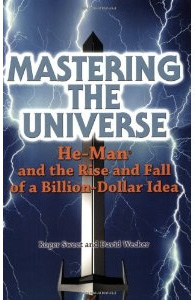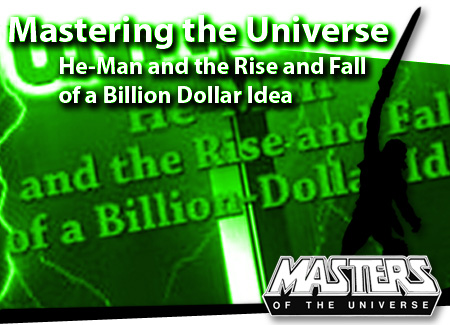Reading – Mastering the Universe
Published in 2005, Mastering the Universe: He-Man and the Rise and Fall of a Billion-Dollar Idea* is over 200-pages covering Mattel designer Roger Sweet’s take on how Masters of the Universe was created in the early eighties . . . and how and why the line collapsed in 1987. I’ve mentioned the book before, and in celebration of Masters of the Universe Day I thought it was time I offered more than just the occasional comment.
It’s time we dig into this book . . . and time I say that you should own this book if you’re a Masters of the Universe fan.

A Masters of the Universe History
Sweet outlines his take on the birth of the Masters of the Universe series, twice going over the product design presentation in which the three designs he created were shown to higher ups at Mattel. Masters of the Universe fans have seen modern takes on these three designs — Mattel released a Vykron set* a few years ago that mimics the three designs — and it’s fun to read Sweet discuss how the toys were initially crafted for the presentation.
The writing throughout the book feels like stream of consciousness work more than polished text, but it’s an entertaining read and gives us a peek at how Mattel operated in the eighties. And, according to the book, Sweet was given almost no support at the early stages of the line’s creation. Sweet writes:
“So while I would have preferred working harmoniously as part of a team, I realized that a hard ball was being thrown. That being the case, I resolved to pull out all the stops to come out a winner, whatever effort it would take.”
And that leads to one of my complaints with the book. Much of the text feels confrontational, with Sweet breaking the narrative history to point out instances in which he felt as if others were . . . well, I’m not sure how to best describe it. Much of the time I feel like Sweet thinks there were people at Mattel seeking ways to remove him from projects, prevent him from succeeding, and to claim credit for his work.
While a straght forward and objective look at the Masters of the Universe line would be great, this book is not that. It’s very much Sweet’s take on things, and it’s a very entertaining take.
Item by Item
There’s one section of Mastering the Universe: He-Man and the Rise and Fall of a Billion-Dollar Idea*, starting on page 203 and running for more than twenty pages, in which Sweet goes item by item through many Masters of the Universe toys that he had not yet touched on earlier in the book.
I’ve referred to this section of the book before — see “The Awesome Fun of the Masters of the Universe Land Shark — and with almost sixty classic Masters of the Universe toys discussed I’ll very likely reference this section again and again over the coming years. I hate to suggest that this is the best part of the book, but it’s hard for me not to at least tell all of you that it’s the one section of the book you must read if you get the chance.
Closing Thoughts
While it’s not the greatest book about toys in my library, Mastering the Universe: He-Man and the Rise and Fall of a Billion-Dollar Idea* is one of the few titles dedicated to Masters of the Universe and that makes it an invaluable reference. I still very much want an eighties Masters of the Universe toy book (I’ve asked for this before), but even if such a book is ever published Sweet’s look at the line will remain important.
I truly believe that anyone who collects Masters of the Universe toys needs to read this book at least once, if not actually own it. I’ve now had my copy for over five years and I cannot see myself ever removing it from my library. And that’s why I’m forced to admit that despite the often less-than-humble tone it’s I enjoy reading whenever I’m researching the old Masters of the Universe line.
Related articles
- How The Sony-Mattel Barbie Movie Could Re-Energize The Brand (forbes.com)
- 12 Most Awesome 1980s Action Figure Toy Lines (geektyrant.com)


I’m a fan of this book, but it definitely has a very confrontational tone to it. I think it was Poe Ghostal who pointed out that it reads like a legal deposition in many places. You know, perhaps Sweet was going to sue Mattel (maybe he already has, although I’ve never heard) and then decided to turn it into a book. Still, it has an interesting look at the toy making process from one person’s opinion. Many of Sweet’s thoughts do seem to echo the corporate culture of Mattel at the time as a few other books and interviews by different individuals have pointed out.
So far as MOTU history goes, this book is only secondary to the Power and Honor Foundation’s First Catalogue.
@Barbecue17 – #2 ranking sounds about right. But if we could get a proper toy guide to that MOTU line of the eighties I feel this would fall to #3.
Too bad the second P&H book never happened.
@Philip Reed- I really think that a book or books covering the vintage toylines would be fantastic. We’ve got plenty of books covering Star Wars, G.I. Joe, Transformers, and other properties; Masters needs its go. This seems like it might be a good effort for the P&H Foundation because a book like this would be them simply documenting and offering critique on items that were already released by the manufacturer for sale without having to publish any of the contested, non-released artwork from their archives. Might be a nice way for them to generate some revenue for their future endeavors while filling a much needed gap.
This is a very interesting read, and for anyone with more than a passive nostalgic interest in MOTU should read it. I don’t own it myself, I actually borrowed Poe Ghostal’s copy, but it’s on my wishlist.
@Prfkt Tear – I see now the book’s basically out of print and some dealers are starting to charge too much for it. Hopefully it will be released in a reprint; a site like Lulu would be perfect to keep it available at a reasonable cost.
Yeah, confrontational is putting it mildly. I’m not sure what bugged me more about the book, his irrational need to describe the height and weight of every co-worker (because he clearly has body confidence issues), or when he’d get facts and dates wrong. He repeatedly states that the 3.75 inch G.I. Joe figures were already on the market (and influencing his design) when he was developing He-Man, which is off by about two years with He-Man debuting first. He also sites the Teenage Mutant Ninja Turtles as a factor in the downfall of He-Man during 1987, which is also a year or two off and not a factor in that years drop in profits. The thing that hits home the most is the factual errors in the actual MOTU line. He takes the time to describe a bunch of the figures in detail citing how creative the design was, yet gets a couple wrong. He describes Webstor as having a string going through his head and coming out his hind quarters when he simply had a back pack with a string running through it, while he describes Kobra Kahn as having a detachable head that you filled with water that would act as a squirt gun, when in fact you filled his body with water and the head only detached to allow the body to be filled. I know these are minor “fanboy” quibbles, but when he’s trying to win over an audience of readers to the facts that his designs were so clever he should probably get them right. It also doesn’t help that he dedicates an entire chapter to the very “crib notes” version of the development of boys figural toys over the last two hundred years, that in the end just makes him seem like he’s trying to be more knowledgeable on a subject than he really is.
At least the book has come down in price since it went out of print. It was selling for like $150 used for awhile there. :p
What’s interesting is that some of the bizarre designs like sweet mentions were definitely the early designs for those figures. The P&H Foundation has published some great artwork showing the design work for Webstor with the cord actually moving through his head and torso and for Khan seeming to have a removable head that was a more self contained squirting apparatus. I’m wondering if Sweet just paid little attention to the figures after they reached a certain point in the design process and became final product.